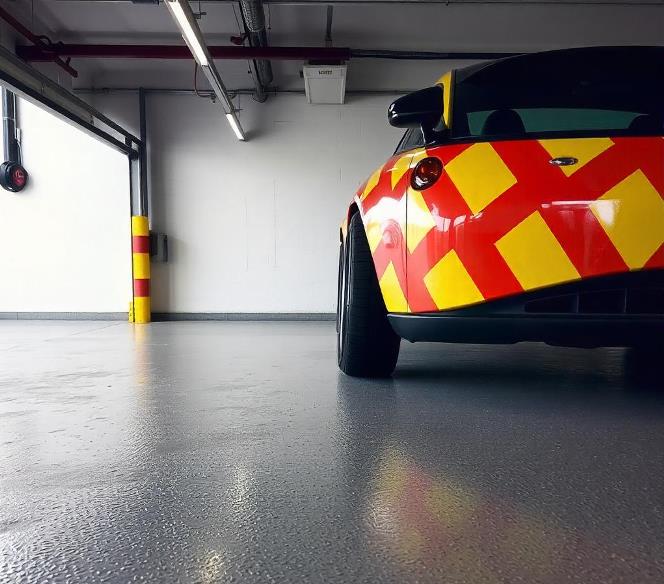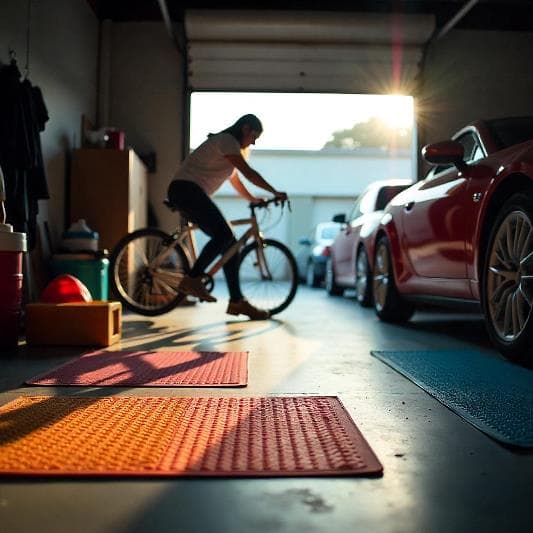A slippery garage floor can pose a serious safety hazard for both you and your family. Whether you use your garage for parking, storage, or as a workspace, maintaining a safe, slip-resistant surface is essential.
Homeowners often overlook the need to improve garage floor traction, yet taking proactive measures is essential to ensuring safety. Fortunately, there are both short-term fixes and long-lasting solutions available to make your garage floor more slip-resistant.
Here, we will discurss the most effective options to improve traction, enhance safety, and protect your flooring.
Why Garage Floors Get Slippery?
Garage floors can become slippery for a variety of reasons:
- Moisture Accumulation: Rain, snow, or high humidity can create a film of water on the surface of the garage floor, making it slick.
- Oil And Grease Spills: Over time, cars leak oil, brake fluid, or coolant, which creates a slippery residue.
- Smooth Concrete Surface: Most garage floors are made of polished concrete, which becomes slippery when wet or dirty.
- Dust And Debris Buildup: Dust mixed with moisture or oils can further increase the risk of slips and falls.
Read Also: Why is Water Coming Up Through My Concrete Floor When It Rains?
Short-Term Solutions for a Slippery Garage Floor
When faced with a slippery garage floor, immediate action can help reduce hazards and prevent accidents. While these solutions may not offer permanent fixes, they are cost-effective, easy to implement, and provide quick relief from slippery surfaces.
Below are some practical short-term options you can consider.
Cleaning Regularly
One of the simplest ways to maintain traction on your garage floor is through consistent cleaning. Regularly sweeping and mopping the floor can prevent the accumulation of dust, dirt, and debris, which, when combined with moisture, create slippery surfaces.
For areas exposed to oil or chemical spills, using a degreasing cleaner can help remove hazardous residues.
How to clean effectively:
- Start by sweeping away loose debris like leaves and dirt.
- Use a mop or a pressure washer with a suitable cleaner designed for concrete.
- For oil stains, apply a degreasing solution or detergent, scrub thoroughly, and rinse with water.
- Repeat this cleaning process regularly to prevent buildup.
Using Absorbent Materials
If your garage frequently experiences oil or water spills, placing absorbent materials on the floor can help reduce slipperiness. Common absorbent options include sawdust, kitty litter, or commercially available absorbent granules. These materials soak up spills, preventing slick spots from forming.
Anti-Slip Mats
Anti-slip mats are an easy and quick fix for areas that need immediate traction improvement. These mats, typically made from rubber or other textured materials, can be strategically placed in high-traffic areas or under vehicles to prevent slips. They’re particularly useful near garage entrances, where water, snow, or mud is often tracked in.
Anti-Slip Tapes
Anti-slip tape is another quick and affordable solution for creating more traction on slippery spots. These tapes have a rough, gritty surface that provides grip when walked on. They are ideal for small problem areas or high-traffic zones in the garage.
Dehumidifiers and Fans
Moisture is a common cause of slippery floors, especially in humid climates or during the colder months when condensation forms. Installing a dehumidifier in your garage can help reduce moisture in the air, preventing condensation from making the floor slick.
Similarly, using fans to increase airflow can help dry wet areas faster.
Long-Term Solutions for a Less Slippery Garage Floor
While short-term solutions offer immediate relief, long-term fixes provide more durable, lasting improvements to your garage floor’s traction.
These solutions typically involve some level of investment in materials and time, but they significantly reduce the need for frequent maintenance and increase safety in the long run. Here are several long-term methods for making your garage floor less slippery.
Epoxy Coatings
Epoxy coatings are one of the most popular long-term solutions for slippery garage floors. Epoxy is a durable resin that creates a smooth but tough surface capable of withstanding heavy traffic, chemicals, and moisture.
When mixed with anti-slip additives such as sand or grit, it becomes a highly effective way to increase traction while maintaining an attractive, polished finish.
Anti-Slip Floor Paint
Anti-slip floor paint is another effective and budget-friendly option for making a garage floor less slippery. This type of paint is specifically designed for concrete and is often mixed with abrasive materials, such as grit or sand, to enhance traction.
It can be applied directly to the garage floor, offering a simple DIY solution that improves safety while giving your garage a fresh look.
Non-Slip Additives
For homeowners who already have a sealant or coating on their garage floor, adding non-slip additives is a quick and effective upgrade.
These additives typically made from materials like silica, aluminum oxide, or polymer grit — are mixed into paint, sealants, or epoxy to create a textured surface that enhances traction.
Textured Floor Tiles
Textured or interlocking garage floor tiles provide a more permanent and aesthetically pleasing solution to slippery surfaces. These tiles are typically made from rubber, vinyl, or PVC and feature a non-slip surface designed for high traction.
The tiles interlock to cover the entire floor or specific areas, creating a durable, slip-resistant surface.
Concrete Etching or Grinding
Concrete etching or grinding is a more advanced solution that involves roughening the surface of the concrete to increase traction.
Etching uses an acid solution to create a slightly rough surface, while grinding uses specialized tools to mechanically roughen the concrete. Both methods remove the smooth, slick top layer of the concrete, making it less slippery.
Installing Drainage Systems
Proper drainage is essential to preventing slippery conditions caused by water pooling in your garage. Installing a drainage system, such as floor drains or sloped flooring, can help divert water away from the surface and prevent the formation of slick, wet spots. This solution is particularly useful for garages in areas with heavy rain or snow.
Safety Measures to Complement Floor Solutions
Even with long-term solutions in place to make your garage floor less slippery, additional safety measures can further reduce the risk of accidents.
These complementary strategies not only support the effectiveness of floor treatments but also address common hazards related to garage use and environment. Implementing these safety measures can make your garage a much safer and more functional space.
Proper Drainage
Water pooling on the garage floor is one of the leading causes of slips and falls. Even with non-slip coatings or textured floors, standing water can create a slick surface. Ensuring proper drainage is critical to keeping the floor dry and safe.
Ramps and Slopes
For garages that frequently encounter water runoff, adjusting the floor’s slope or adding ramps can help manage water flow and reduce slipperiness.
This method is particularly useful for garages that have minimal drainage or are located on sloped properties where water can accumulate.
Regular Maintenance
Maintaining a slip-resistant garage floor requires consistent upkeep, even with long-term treatments in place.
Over time, coatings, tiles, and non-slip surfaces may wear down, reducing their effectiveness. Scheduling regular cleaning and maintenance will help keep your floor in optimal condition.
Appropriate Footwear
Even with slip-resistant surfaces, wearing proper footwear can greatly reduce the likelihood of slipping in a garage. Shoes with slip-resistant soles are designed to provide better grip on slick or wet surfaces, making them ideal for walking in areas like garages.
Adequate Lighting
Poor lighting can increase the risk of accidents, especially in garages where visibility might already be compromised by shadows, clutter, or vehicles.
Installing proper lighting ensures you can see potential hazards, like spills, wet spots, or debris, before they become dangerous.
Organizing the Garage to Avoid Clutter
A cluttered garage can increase the risk of slips, trips, and falls. Tools, equipment, and other items left scattered across the floor can become hidden hazards, particularly when the floor is wet or dirty.
Organizing your garage helps keep walkways clear and reduces the risk of accidents.
Conclusion
Maintaining a safe, slip-resistant garage floor is essential for preventing accidents and improving the overall functionality of your garage.
Slippery surfaces can result from a combination of factors, including moisture, oil spills, and smooth concrete finishes. Addressing these hazards through a combination of short-term and long-term solutions will not only improve safety but also increase the longevity of your garage floor.


